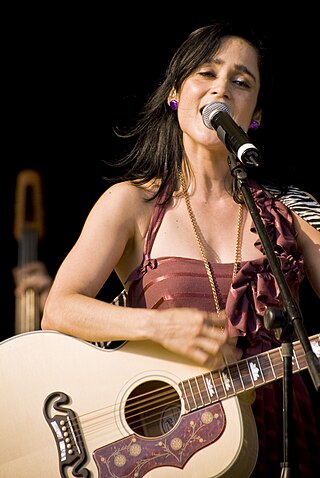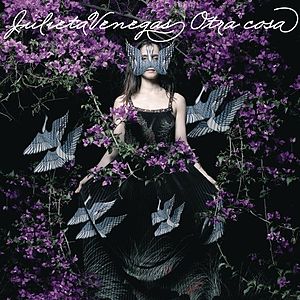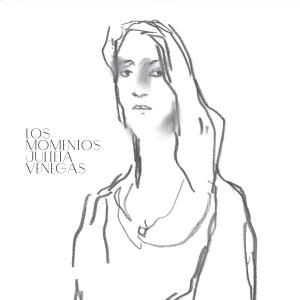
Ryland Peter Cooder is an American musician, songwriter, film score composer, record producer, and writer. He is a multi-instrumentalist but is best known for his slide guitar work, his interest in traditional music, and his collaborations with traditional musicians from many countries.

The music of Mexico is highly diverse, featuring a wide range of musical genres and performance styles. It has been influenced by a variety of cultures, primarily deriving from Europeans, Indigenous, and Africans traditions. Occasionally, there are also influences from Asians and Arabs cultures, as well as other Hispanic and Latino influences. Music became an expression of Mexican nationalism starting in the nineteenth century.

Ana Lila Downs Sánchez is a Mexican singer-songwriter. She performs her own compositions and the works of others in multiple genres, as well as tapping into Mexican traditional and popular music. She also incorporates indigenous Mexican influences and has recorded songs in many indigenous languages such as Mixtec, Zapotec, Mayan, Nahuatl and Purépecha. Born and raised in Oaxaca, she primarily studied at the Institute of Arts by Oaxaca and briefly attended the University of Minnesota, before withdrawing to focus on her musical career. She soon began performing in the traditional music scene of Oaxaca City.

María Natalia Lafourcade Silva is a Mexican pop-rock, jazz and folk singer and songwriter who, since her debut in 2002, has been one of the most successful singers in Latin America. Lafourcade's voice has been categorized as a lyric soprano.

Julieta Venegas Percevault is an American-born Mexican singer, songwriter, instrumentalist and producer who sings pop-rock-indie in Spanish. She went on to join several bands including Mexican ska band Tijuana No!. Venegas plays 17 instruments including acoustic guitar, accordion, and keyboard.

Son jarocho is a regional folk musical style of Mexican Son from Veracruz, a Mexican state along the Gulf of Mexico. It evolved over the last two and a half centuries along the coastal portions of southern Tamaulipas state and Veracruz state, hence the term jarocho, a colloquial term for people or things from the port city of Veracruz.

"Eres Para Mí" is a Latin pop-Hip hop song by the Mexican singer-songwriter Julieta Venegas and the Chilean singer Anita Tijoux. It was recorded for Julieta Venegas's studio album Limón y Sal. Released as the third single on January 1, 2007. It had the same success as her first single "Me Voy" in Latin America appearing at the top of the pop charts.

Anamaría Tijoux Merino, commonly known by her stage name Ana Tijoux or Anita Tijoux, is a Chilean-French singer and musician. She became famous in Latin America as the MC of hip hop band Makiza during the late 1990s. In 2006, she crossed over to the mainstream of Latin pop after her collaboration with Mexican singer Julieta Venegas in the radio hit "Eres para mí". Tijoux has often been praised for "exploring sensitive matters devoid of violence." She gained more widespread recognition following her second solo album, 1977, and later with La bala (2011) and Vengo (2014) which brought her a Best Artist of the year award in the 2015 Pulsar Awards.

Bajofondo is a Río de la Plata-based music band consisting of eight musicians from Argentina and Uruguay, which aims to create a more contemporary version of tango and other musical styles of the Río de la Plata region. It was founded in the early 2000s as a studio experiment, which culminated into the successful album Bajofondo Tango Club. This led to touring and eventually to the current lineup. Bajofondo calls itself a collaborative as all members have solo careers as well. The group has toured around the world, particularly in Latin America, the United States, Europe and parts of Asia. Their music is known to a wider audience than those who know their name as their music has been used in film and television.

Otra Cosa is the title of the fifth studio album by Mexican singer-songwriter Julieta Venegas, released worldwide on March 16, 2010. iTunes sold two versions of this album, the standard version and an iTunes LP, and it became the first iTunes LP released by a Latin artist. The deluxe iTunes release includes the music video for the single "Bien o Mal," as well as a remix by the Mexican Institute of Sound. The album was also released exclusively in Mexico in format of vinyl.

"Andar Conmigo" is the lead single by Mexican singer Julieta Venegas from her third studio album Sí (2003). The song was nominated for Latin Grammy Award for Song of the Year.

San Patricio is an album by the Irish musical group, The Chieftains featuring Ry Cooder, released in 2010. It was their first album with Hear Music and the first studio album in over six years since Further Down the Old Plank Road (2003). It tells the story of the San Patricio battalion—a group of mainly Irish immigrant volunteer soldiers who deserted the U.S. Army in 1846 to fight on the Mexican side in the Mexican–American War (1846–1848). The album features collaborations with Moya Brennan, Linda Ronstadt, Liam Neeson, Los Cenzontles, Los Tigres del Norte, Lila Downs, Van Dyke Parks, Carlos Núñez, and Chavela Vargas. The album artist is El Moisés.

Gerardo Horacio López von Linden, known professionally as Cachorro López, is an Argentine record producer, musician and songwriter. Born in Buenos Aires, Argentina, he enrolled in various musical ensembles, including Zas and Los Abuelos de la Nada. López has worked with several artists producing their albums, including Caifanes, Stephanie Salas, Andrés Calamaro, Paulina Rubio, Diego Torres and Miranda!. López also was the executive producer of the tribute album for the English band Queen in 1997. His work has been recognized with two Latin Grammy Awards for Producer of the Year in 2006 and 2009, out of four consecutive nominations, and a Grammy Award for producing Limón y Sal by Julieta Venegas.

Pecados y milagros is the seventh studio album by Mexican singer-songwriter Lila Downs, released on October 18, 2011. The album cover was released on September 14, 2011.

Son mexicano is a style of Mexican folk music and dance that encompasses various regional genres, all of which are called son. The term son literally means "sound" in Spanish, and is also applied to other unrelated genres, most notably son cubano.

Los Momentos, the sixth studio album by Mexican recording artist Julieta Venegas, was released 19 March 2013 by Sony Music Mexico. The first single from Los Momentos is "Tuve Para Dar," and the album features collaborations with Ceci Bastida, Natalia Lafourcade, Ana Tijoux and Rubén Albarrán.
Las Cafeteras is a Chicano band from East Los Angeles, California. Their music fuses spoken word and folk music, with traditional Son jarocho and zapateado dancing.

Shake Away is the sixth studio album by Mexican singer-songwriter Lila Downs. It was released on 2 September 2008 on Manhattan Records. After attaining international success in 2001 with her first English record, Border, Downs wanted to release a fifth Spanish-English language project as its followup. In the vein of her earlier work, the album is heavily influenced by world music, flamenco and rock. Downs enlisted Paul Cohen as executive producer, also working with Celso Duarte, Brian Lynch and Aneiro Taño.

Lunas del Auditorio is a recognition given by the Auditorio Nacional to the best live concerts in Mexico. The prize is a replica of the sculpture of the Moon by sculptor Juan Soriano. The ceremony is broadcast by Televisa, TV Azteca, Channel 22 of the Secretariat of Culture and Canal Once of the National Polytechnic Institute of Mexico.



















